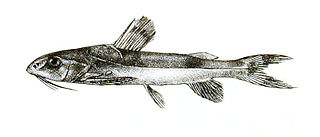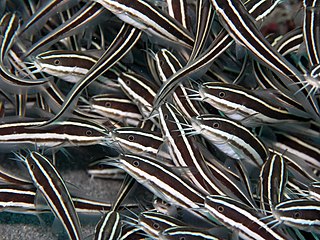
Erethistidae are a family of catfishes that originate from southern Asia. It includes about 45 species.
Myersglanis is a genus of sisorid catfishes native to Asia.

Steindachneridion is a genus of South American pimelodid catfish.

Erethistes is a genus of South Asian river catfishes.

Pseudecheneis is a genus of sisorid catfishes native to Asia.

Bagarius is an Asian genus of catfishes of the family Sisoridae. It includes five to six extant species and potentially one extinct fossil species, B. gigas.
Exostoma is a genus of sisorid catfishes native to Asia. These species are distributed in the Brahmaputra drainage of north-eastern India, and east and south to the Salween drainages in Burma. E. berdmorei is found in the Sittang and Salween drainages in Burma. E. labiatum is known from the Brahmaputra drainage in north-eastern India, but has also been recorded in the Salween drainage in Burma, the Ayeyarwady drainage in China, and the Brahmaputra drainage in Tibet and Burma. E. stuarti is from the Ayeyarwady River of Burma and India; however, it has not been collected since its original discovery. E. labiatum is found in mountain rapids.

Glyptosternon is a genus of sisorid catfishes native to Asia.

Gogangra is a genus of sisorid catfishes native to Asia.

Sisor is a genus of catfishes native to Asia.

Gagata is a genus of sisorid catfishes native to Asia.
Breitensteinia is a genus of catfishes of the family Akysidae. It includes three species.

Paraplotosus is a genus of catfishes native to Australasia and South-east Asia.

Plotosus is a genus of eeltail catfishes native to the Indian Ocean, the western Pacific Ocean and New Guinea.
Hoplomyzon is a genus of banjo catfishes that are native to tropical South America.
Zaireichthys mandevillei is a species of loach catfish found in the Central African Republic and the Democratic Republic of the Congo where it is found in the Congo River Basin. It grows to a length of 2.6 cm and has a broad, black collar just behind the head and a spotted colour pattern. The barbels are attenuate, with the maxillary barbels extending posteriorly to middle to end of the pectoral fin spine and the caudal peduncle is slender. The humeral process of the pectoral girdle is short and without denticulations. The caudal fin is deeply forked, with the upper lobe much shorter and smaller than the lower lobe; also, the fin rays in lower lobe noticeable thicker than those in upper lobe.
Erethistoides infuscatus is a species of South Asian river catfish native to India and Bangladesh where it is found in the drainages of the Brahmaputra and Meghna Rivers. This species grows to a length of 4.5 centimetres (1.8 in) SL.
Synodontis acanthoperca, known as the scissortail synodontis, is a species of upside-down catfish native to Gabon where it occurs in the Ogowe River. It was first described by John Patrick Friel & Thomas R. Vigliotta in 2006, based upon a holotype discovered in the Ogooué River in Gabon, at and below the Rapids of Massoukou. The specific name "acanthoperca" comes from the Latinized combination of the Greek word acantha, meaning "thorn", and the Latin opercul, meaning cover or lid, which refers to the pronounced spines that develop on the operculum of mature males.
Gogangra laevis is a species of sisorid catfish found in Bangladesh where it occurs in the Jamuna and Meghna River drainages. This species grows to a length of 8 centimetres (3.1 in) SL.
Pseudolaguvia spicula is a species of sisorid catfish in the family Erethistidae. It is found in the Surma-Meghna River system in India and Bangladesh.










